Performances and Environmental Impacts of Connected and Autonomous Vehicles for Different Mixed-Traffic Scenarios
Abstract
1. Introduction
1.1. Motivation of the Study
1.2. Literature Review
- Impacts on traffic congestion: CAVs are supposed to reduce congestion in different ways. Firstly, the advanced technological system allows vehicles to stop instantly when required, so that they can travel with reduced headways. As reported in [8], this can lead to increases in road capacity, with the consequent reduction in congestion. Moreover, real-time information shared by the system could perform an instantaneous recalculation of the vehicle’s route based on the received data, so that it could take alternative roads, avoiding congested situations [15,16]. The optimization of signal settings, mainly due to V2I technology, can contribute to reducing congestion [17].
- Impacts on land use: As cars with a high level of automation can move independently from human guidance, they are able to provide an on-demand service, moving people when they request and then, independently, going away from the destination point. This could lead to a drastic reduction in parking demand, with the possibility of using parking spaces for different purposes within cities’ development [18]. Furthermore, the whole infrastructure system should be rethought, as several elements would become superfluous (e.g., traffic lights, road lighting and lane division) [15].
- Impacts on consumer choices: One of the capabilities of CAVs is the possibility of being used in sharing [5]. Different studies stated that this could lead to a reduction in car ownership, as the vehicle can be used by all the family at the same time, while, on a broader level, driverless taxis services or autonomous car sharing programs could potentially be cheaper travel options if compared with the costs of buying, owning, and maintaining a car [5,15]. Unfortunately, there is no agreement among scholars on this assumption. In fact, as reported in [8], the results of interviews with a sample of 302 people [20] have clearly shown that people prefer to own a vehicle (either human-driven or autonomous) than to use sharing services (whether traditionally or autonomously driven). Hence, the role of CAVs in promoting sharing mobility is still an open discussion.
1.3. Paper Organization
2. Methodology
- “Cautious”, where vehicles observe the road code, always adopting safe behaviour in all their manoeuvres. Usually, this option is set for level 1 or level 2 of automation;
- “Normal”, where vehicles behave like human drivers, with the additional capacity of using their sensors for monitoring spacings and speed of the surrounding vehicles. These parameters are typically set for simulating level 3 of automation;
- “All-knowing”, in which vehicles have total awareness and predictive capabilities, characterized by smaller gaps for all manoeuvres and situations. This set of parameters is usually used for the simulation of the higher automation levels.
- Acceleration Distributions: in human driving behaviour, the acceleration distributions are composed of three different curves. The first two represent the lower and the upper limit of the distribution, while the last curve represents the mean value. These three curves constitute a large range, in which the accelerations of the human driver take place. As regards connected and autonomous vehicles, the acceleration distributions degenerate in the mean curve, as all vehicles are assumed to have the same value for acceleration. In Figure 2, the two different curves are reported.
- Speed Distribution: human drivers tend to reach their desired speed, which is different for each user, so that the speed distributions in the software have a significantly irregular trend, with high spreads. On the contrary, CAVs tend to strictly obey limits, so that their speed distribution shows, in VissimTM, a linear trend, with much lower spreads. These trends are reported in Figure 3.
- : specific technology, consisting of fuel, vehicle size, EURO standard;
- : speed ;
- : energy consumption for specific technology at speed ;
- : CORINAIR emission factor of technology ;
- : CORINAIR reduction factor of technology ;
- : lower and upper bound of speed in function definition
- : lower and upper bound of speed in function definition ;
- : set of vehicle technologies defined by CORINAIR methodology;
- : number of vehicles in the fleet with technology e ;
- : total number of vehicles in the fleet ;
- : energy consumption of vehicle fleet .
3. Case Study
3.1. Delimitation of the Study Area
3.2. Scenario Definition and Assumptions
- Scenario 1: 100% traditionally driven vehicles;
- Scenario 2: 75% traditionally driven vehicles and 25% CAVs;
- Scenario 3: 50% traditionally driven vehicles and 50% CAVs;
- Scenario 4: 25% traditionally driven vehicles and 75% CAVs;
- Scenario 5: 100% CAVs.
- The first link, identified as link 28, connecting the exit junctions of Via Ardeatina and Via Appia, is characterized by values of density that hover around 65 veh/km in different scenarios;
- The second link, identified as link 71, runs from the exit junction of Morena to the exit junction of Anagnina. Densities are lower than those of link 28;
- The last link connects Via Tuscolana with the highway A1. It is identified as link 49, and shows a situation of congestion, with much higher densities than the other two links.
3.3. Model Calibration
- m are the simulated traffic volumes [veh/h];
- c are traffic volumes from detectors [veh/h].
- is the n-th simulated speed [km/h];
- is the n-th observed speed [km/h];
- is the number of values considered in the sample.
3.4. Changes in Parameters for Human-Driven and CAVs
3.5. Evaluation of the Energy Consumption Curve
4. Results
4.1. Assessments of Road Performances
4.1.1. Mean Speed of Traffic Stream
4.1.2. Variations in Road Capacity
4.1.3. Variations in Travel Times
4.2. Assessment of Energy Consumption
5. Discussion
6. Conclusions
- COPERT methodology, although used everywhere in Europe, as validated by the European Union, does not take into account the reduction of speed variability when CAVs are present. In fact, the COPERT model was calibrated with typical human driving styles, with a highly variable speed between each driving cycle. This variability is assumed to be significantly reduced with the spread of CAVs, so the need for calibrating a new model with these new driving cycles becomes evident;
- Future Scenarios will be characterized by new vehicular fleets with new technological equipment and, probably, new vehicle design, but these aspects cannot be considered beforehand. For these reasons, the analysis was conducted with only one vehicle composition.
- Assess the environmental impact more accurately by considering the variation in speed within the flow;
- Adapt the methodology so that it is independent of the engine technology used;
- Simulate and evaluate different policies to balance performance with sustainability.
Author Contributions
Funding
Institutional Review Board Statement
Informed Consent Statement
Data Availability Statement
Conflicts of Interest
References
- Makridis, M.; Mattas, K.; Mogno, C.; Ciuffo, B.; Fontaras, G. The impact of automation and connectivity on traffic flow and CO2 emissions. A detailed microsimulation study. Atmos. Environ. 2020, 226, 117399. [Google Scholar] [CrossRef]
- Rios-Torres, J.; Malikopoulos, A.A. Impact of Partial Penetrations of Connected and Automated Vehicles on Fuel Consumption and Traffic Flow. IEEE Trans. Intell. Veh. 2018, 3, 453–462. [Google Scholar] [CrossRef]
- Yazdizadeh, A.; Farooq, B. Smart Mobility Ontology: Current Trends and Future Directions. In Handbook of Smart Cities; Springer: Berlin/Heidelberg, Germany, 2021. [Google Scholar]
- Holmberg, P.; Collado, M.; Sarasini, S.; Williander, M. Mobility as a Service—Maas, Describing the Framework; Vinnova Project; Swedish Viktoria: 2016; Vinnova Project; Swedish Viktoria: Stockholm, Sweden, 2016. [Google Scholar]
- Faisal, A.; Yigitcanlar, T.; Kamruzzaman, M.; Currie, G. Understanding autonomous vehicles: A systematic literature review on capability, impact, planning and policy. J. Transp. Land Use 2019, 12, 47–72. [Google Scholar] [CrossRef]
- Patella, S.M.; Scrucca, F.; Asdrubali, F.; Carrese, S. Carbon Footprint of autonomous vehicles at the urban mobility system level: A traffic simulation-based approach. Transp. Res. Part D Transp. Environ. 2019, 74, 189–200. [Google Scholar] [CrossRef]
- Carrese, S.; Nigro, M.; Patella, S.M.; Toniolo, E. A preliminary study of the potential impact of autonomous vehicles on residential location in Rome. Res. Transp. Econ. 2019, 75, 55–61. [Google Scholar] [CrossRef]
- Kopelias, P.; Demiridi, E.; Vogiatzis, K.; Skabardonis, A.; Zafiropoulou, V. Connected & autonomous vehicles—Environmental impacts—A review. Sci. Total Environ. 2020, 712, 135237. [Google Scholar] [CrossRef] [PubMed]
- SAE International. Available online: https://www.sae.org/ (accessed on 3 February 2023).
- SAE International. Available online: https://www.sae.org/standards/content/j3016_202104/ (accessed on 3 February 2023).
- McCall, R.; McGee, F.; Mirnig, A.; Meschtscherjakov, A.; Louveton, N.; Engel, T.; Tscheligi, M. A taxonomy of autonomous vehicle handover situations. Transp. Res. Part A 2019, 124, 507–522. [Google Scholar] [CrossRef]
- Lu, N.; Cheng, N.; Zhang, N.; Shen, X.; Mark, J.W. Connected Vehicles: Solutions and Challenges. IEEE Internet Things J. 2014, 1, 289–299. [Google Scholar] [CrossRef]
- Lempert, R.J.; Preston, B.; Charan, S.M.; Fraade-Blanar, L.; Blumenthal, M.S. The societal benefits of vehicle connectivity. Transp. Res. Part D 2021, 93, 102750. [Google Scholar] [CrossRef]
- Rojas-Rueda, D.; Nieuwenhuijsen, M.J.; Khreis, H.; Frumkin, H. Autonomous Vehicles and Public Healt. Annu. Rev. Public Health 2020, 41, 329–345. [Google Scholar] [CrossRef] [PubMed]
- Taiebat, M.; Brown, A.L.; Safford, H.R.; Qu, S.; Xu, M. A Review on Energy, Environmental, and Sustainability Implications of Connected and Automated Vehicles. Environ. Sci. Technol. 2018, 52, 11449–11465. [Google Scholar] [CrossRef] [PubMed]
- Wang, N.; Wang, X.; Palacharla, P.; Ikeuchi, T. Cooperative Autonomous Driving for Traffic Congestion Avoidance through Vehicle-to-Vehicle Communications. In Proceedings of the IEEE Vehicular Networking Conference (VNC), Turin, Italy, 27–29 November 2017. [Google Scholar] [CrossRef]
- Adacher, L.; Cipriani, E. A surrogate approach for the global optimization of signal settings and traffic assignment problem. In Proceedings of the 13th International IEEE Conference on Intelligent Transportation Systems, Funchal, Portugal, 19–22 September 2010; pp. 60–65. [Google Scholar] [CrossRef]
- Anderson, J.M.; Kalra, N.; Stanley, K.D.; Sorensen, P.; Samaras, C.; Oluwatola, O.A. Autonomous Vehicle Technology—A Guide for Policymakers; RAND Corporation: Santa Monica, CA, USA, 2016. [Google Scholar]
- Milakis, D.; van Arem, B.; van Wee, B. Policy and society related implications of automated driving: A review of literature and directions for future research. J. Intell. Transp. Syst. Technol. Plan. Oper. 2017, 21, 324–348. [Google Scholar] [CrossRef]
- Pakusch, C.; Stevens, G.; Bossauer, P. Shared Autonomous Vehicles: Potentials for a Sustainable Mobility and Risks of Unintended Effects. EPiC Ser. Comput. 2018, 52, 258–269. [Google Scholar]
- Zong, S. How Connected Autonomous Vehicles Would Affect Our World?—A Literature Review on the Impacts of CAV and Road Capacity, Environment and Public Attitude. In Proceedings of the MATEC Web of Conferences, ICTLE 2019, Paris, France, 21–23 August 2019; Volume 296. [Google Scholar]
- Litman, T.B. Autonoums Vehicle Implementation Predictions; Victoria Transport Policy Institute: Victoria, BC, Canada, 2017. [Google Scholar]
- Lee, C.W.; Madnick, S. Cybersafety Approach to Cybersecurity Analysis and Mitigation for Mobility-as-a-Service and Internet of Vehicles. Electronics 2021, 10, 1220. [Google Scholar] [CrossRef]
- Pandey, M.; Seetharaman, R. A review of factors imoacting Cybersecurity in Connected and Autonomous Vehicles (CAVs). In Proceedings of the 8th International Conference on Control, decision and Information Technologies (CoDIT’2022), Instanbul, Turkey, 17–20 May 2022. [Google Scholar] [CrossRef]
- Collingwood, L. Privacy implications and liability issues of autonomous vehicles. Inf. Commun. Technol. Law 2017, 26, 32–45. [Google Scholar] [CrossRef]
- Barth, M.; Boriboonsomsin, K.; Wu, G. Vehicle Automation and Its Potential Impacts on Energy and Emissions. In Road Vehicle Automation; Meyer, G., Beiker, S., Eds.; Springer: Cham, Switzerland, 2014; pp. 103–112. [Google Scholar] [CrossRef]
- Cipriani, E.; Fusco, G.; Gori, S.; Petrelli, M. Heuristic methods for the optimal location of road traffic monitoring. In Proceedings of the 2006 IEEE Intelligent Transportation Systems Conference, Toronto, ON, Canada, 17–20 September 2006; pp. 1072–1077. [Google Scholar] [CrossRef]
- Hwang, H.; Song, C. Changes in air pollutant emissions from road vehicles due to autonomous driving technology: A conceptual modeling approach. Environ. Eng. Res. 2019, 25, 366–373. [Google Scholar] [CrossRef]
- Ding, H.; Pan, H.; Bai, H.; Zheng, X.; Chen, J. Driving strategy of connected and autonomous vehicles based on multiple preceding vehicles state estimation in mixed vehicular traffic. Phys. A 2022, 596, 127154. [Google Scholar] [CrossRef]
- Fang, X.; Li, H.; Tettamanti, T.; Eichberger, A.; Fellendorf, M. Effects of Automated Vehicle Models at the Mixed Traffic Situation on a Motorway Scenario. Energies 2022, 15, 2008. [Google Scholar] [CrossRef]
- Wiedemann, R. Simulation des Strassenverehrsflusses; Technical report; Institute for Traffic Engineering, University of Karlsruhe: Karlsruhe, Germany, 1974. [Google Scholar]
- Arvin, R.; Khattak, A.J. Safety evaluation of connected and automated vehicles in mixed traffic with conventional vehicles at intersections. J. Intell. Transp. Syst. Technol. Plan. Oper. 2020, 25, 170–187. [Google Scholar] [CrossRef]
- Gipps, P.G. A model for the structure of lane-changing decisions. Transp. Res. Part B Methodol. 1986, 20, 403–414. [Google Scholar] [CrossRef]
- Akcelik, R. A Review of Gap-Acceptance Capacity Models. In Proceedings of the 29th Conference of Australian Institutes of Transport Research (CAITR 2007), University of South Australia, Adelaide, Australia, 5–7 December 2007. [Google Scholar]
- CoEXist. Available online: https://www.h2020-coexist.eu/ (accessed on 8 February 2023).
- Sukennik, P. Micro-Simulation Guide for Automated Vehicles. 2018. Available online: https://www.h2020-coexist.eu/wp-content/uploads/2018/11/D2.5-Micro-simulation-guide-for-automated-vehicles.pdf (accessed on 20 April 2023).
- Gemma, A.; Cipriani, E.; Crisalli, U.; Mannini, L. Automated Vehicles’ Effects on Urban Traffic Flow Parameters. In Smart Energy for Smart Transport; Nathanail, E.G., Gavanas, N., Adamos, G., Eds.; CSUM 2022, Lecture Notes in Intelligent Transportation and Infrastructure; Springer: Cham, Switzerland, 2023. [Google Scholar] [CrossRef]
- EMEP/EEA. Air Pollutant Emission Inventory Guidebook; European Environment Agency: Copenhagen, Denmark, 2019. [Google Scholar]
- Emisia. Conscious of Transport’s Impact. Available online: https://www.emisia.com/utilities/copert/ (accessed on 20 April 2023).
- Marin, F. Analisi Delle Prestazioni del Deflusso Extraurbano in Presenza di Veicoli Autonomi E Connessi. Master’s Thesis, Roma Tre University, Rome, Italy, 2020. [Google Scholar]
- Transport for London. Traffic Modelling Guidelines, Version 4.0; Beeston, L., Blewitt, R., Bulmer, S., Wilson, J., Eds.; Transport for London: London, UK, 2021.
- PTV AG. PTV Vissim 2020 User Manual; PTV AG: Karlsruhe, Germany, 2020. [Google Scholar]

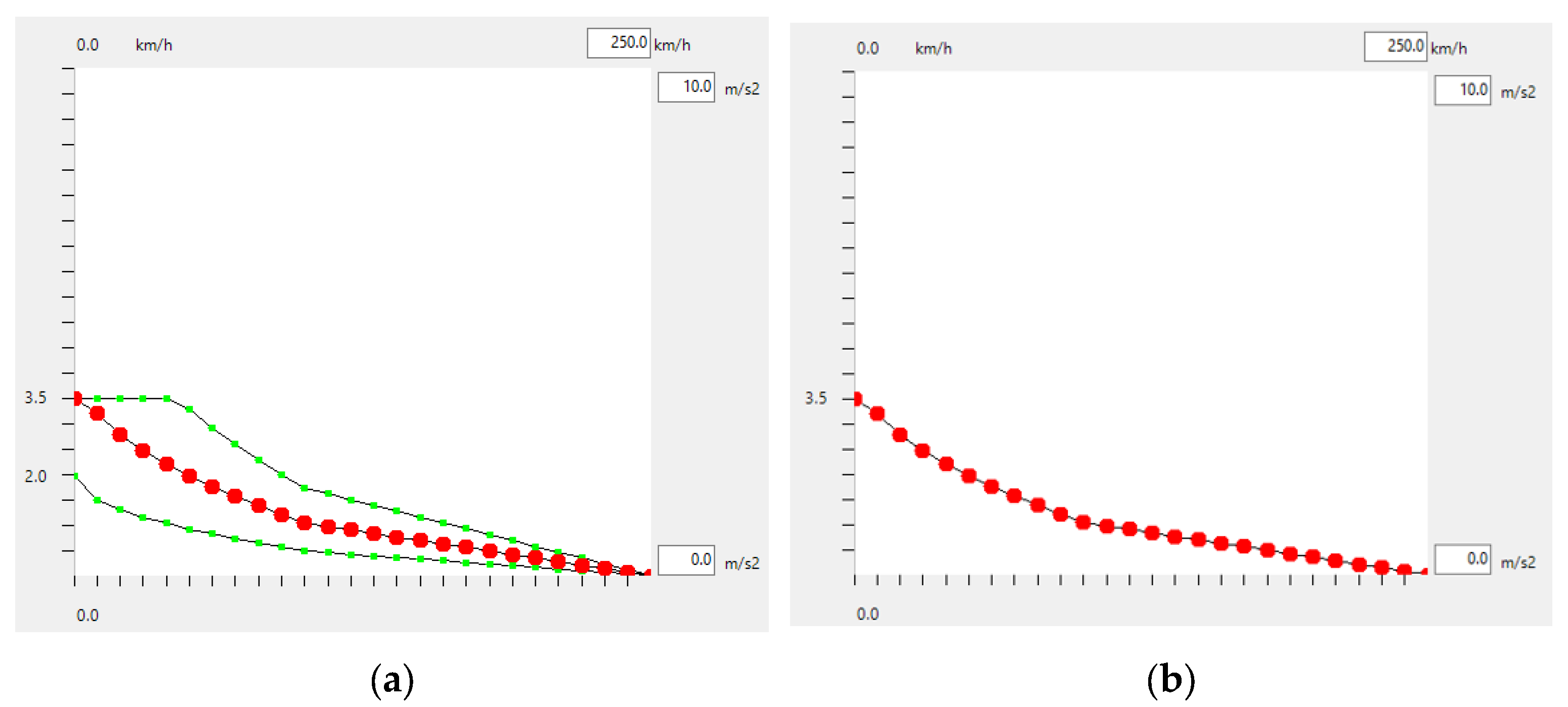
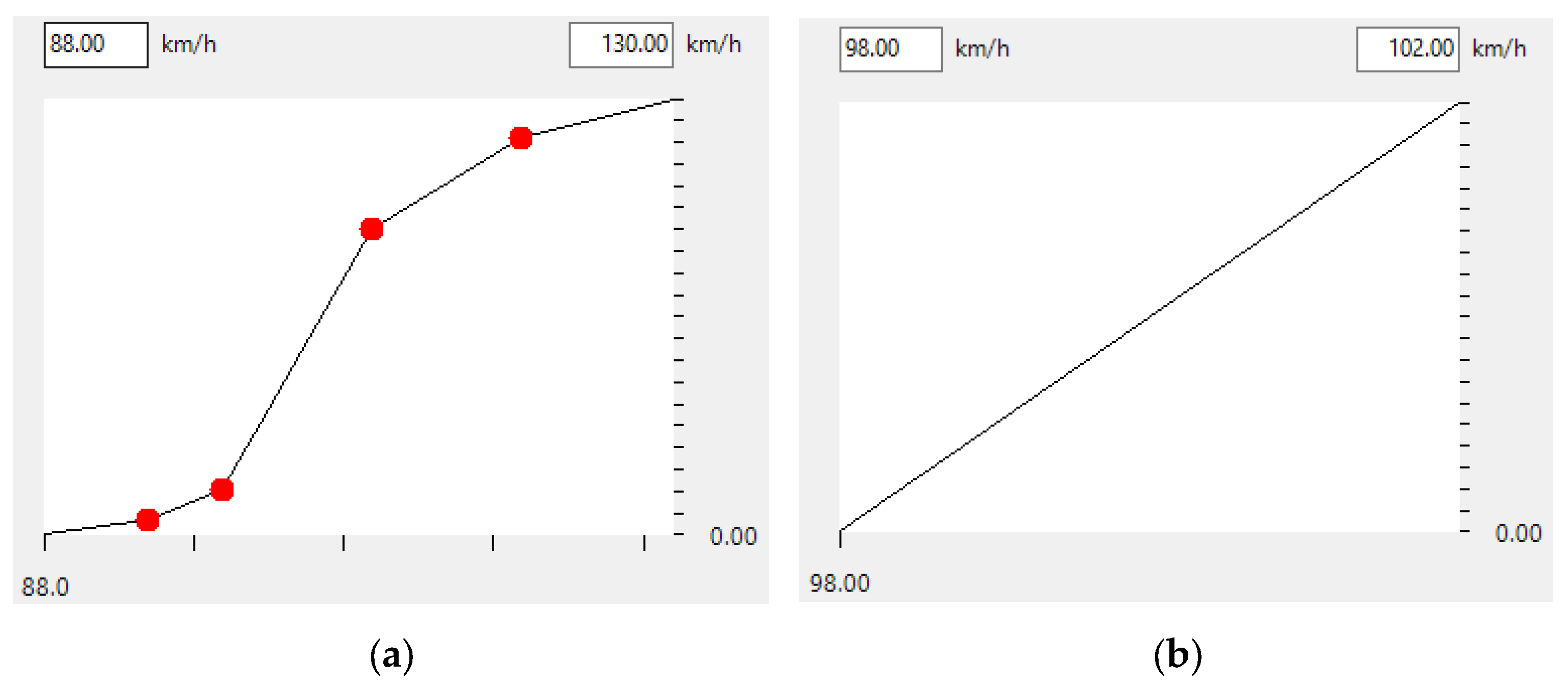
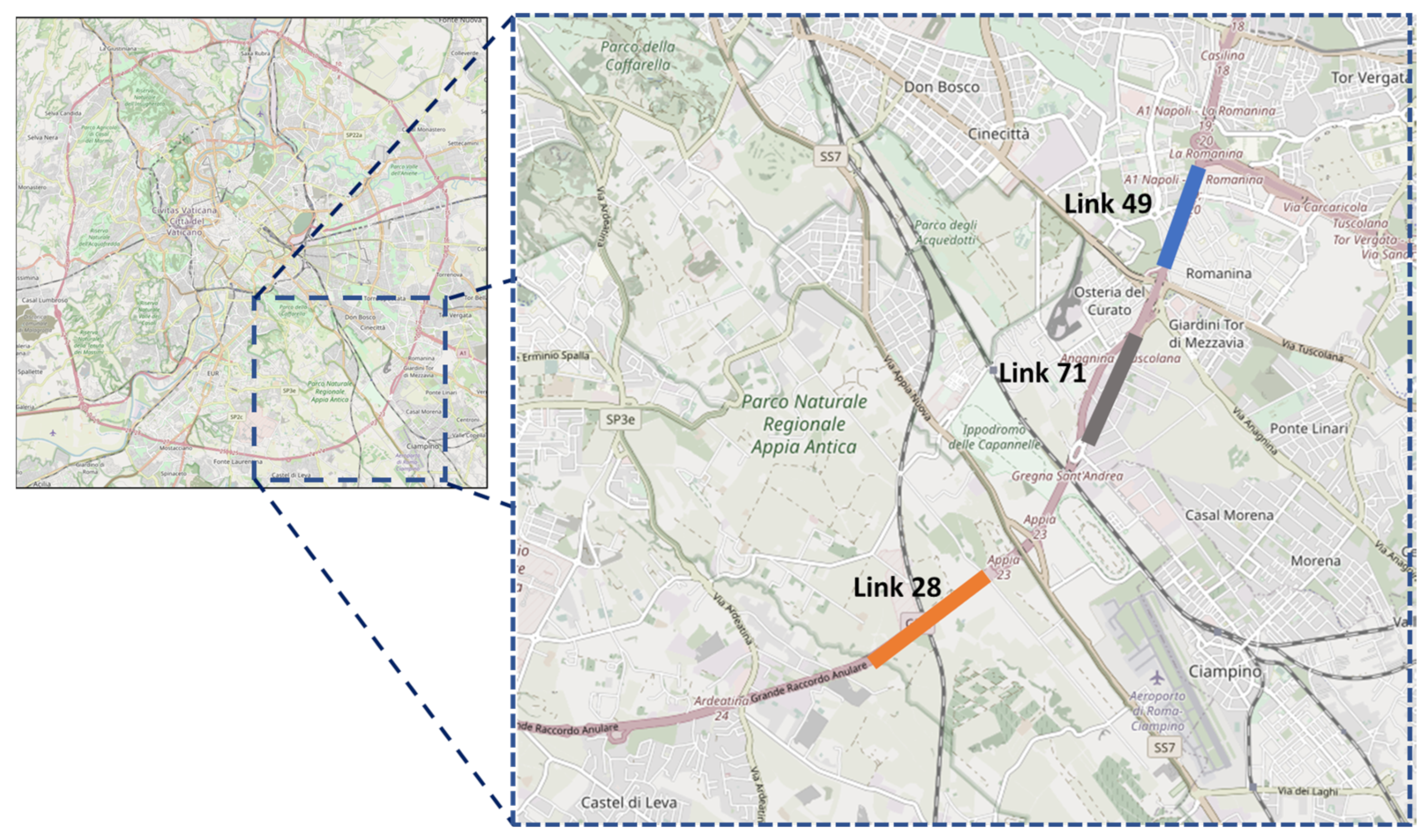
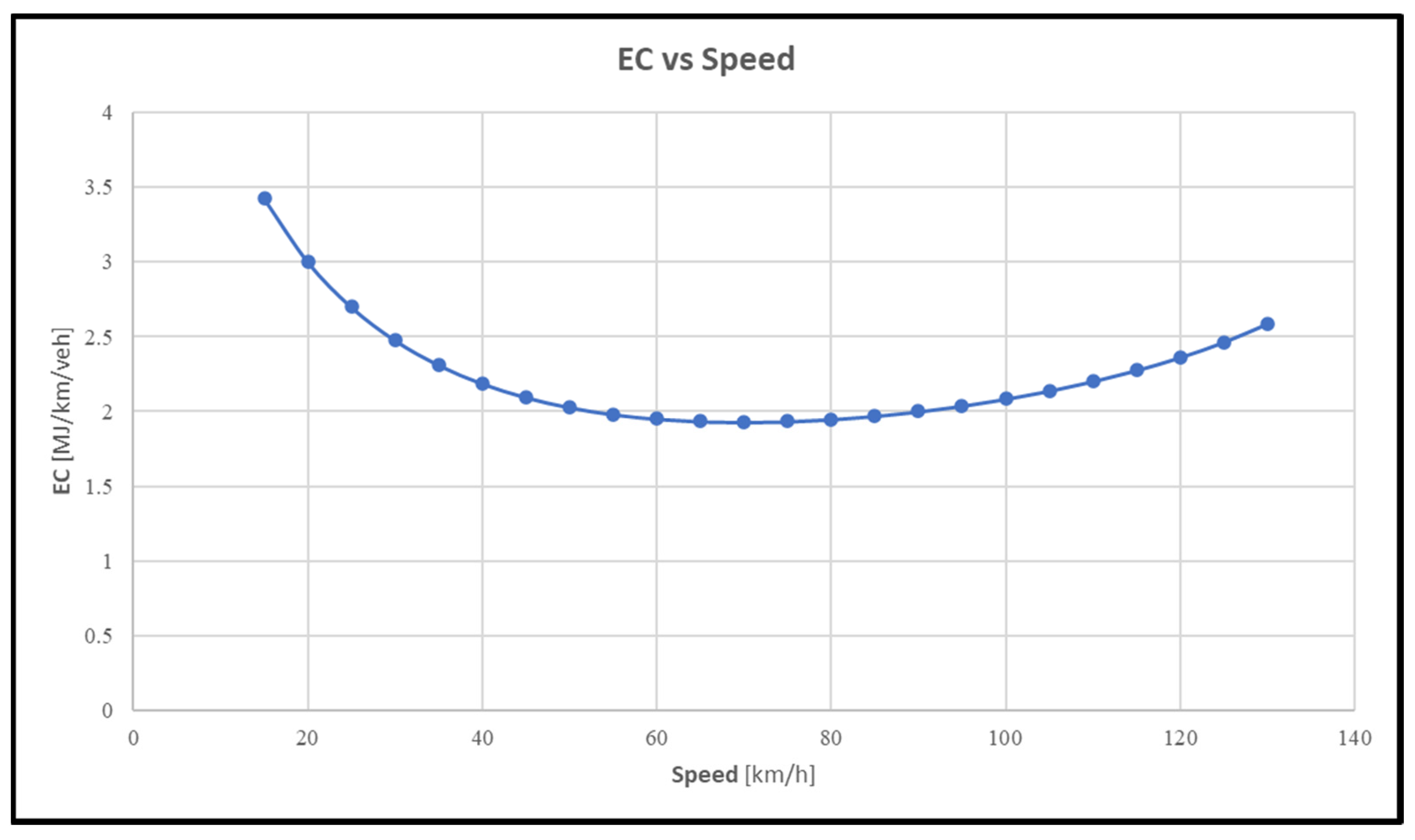

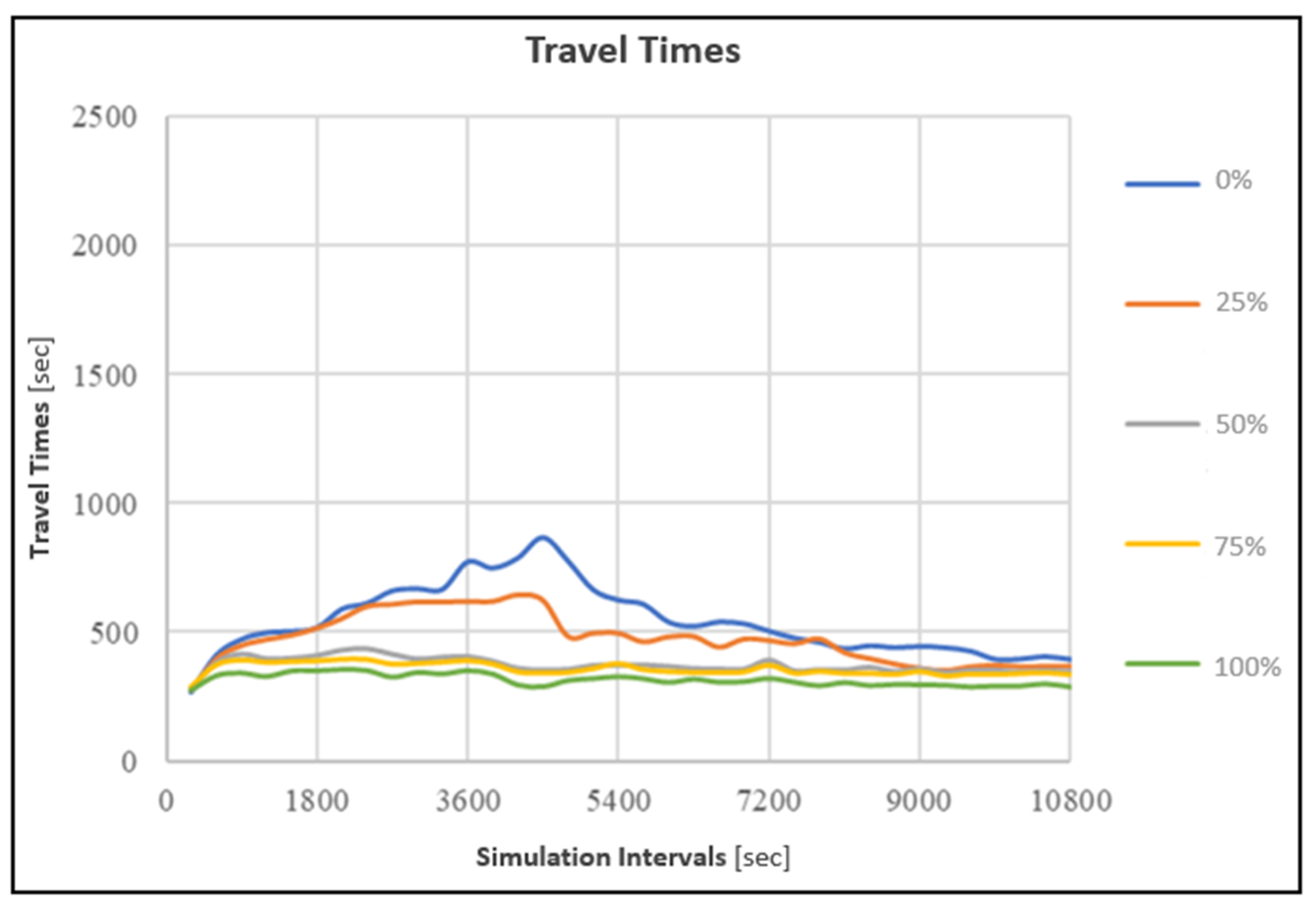
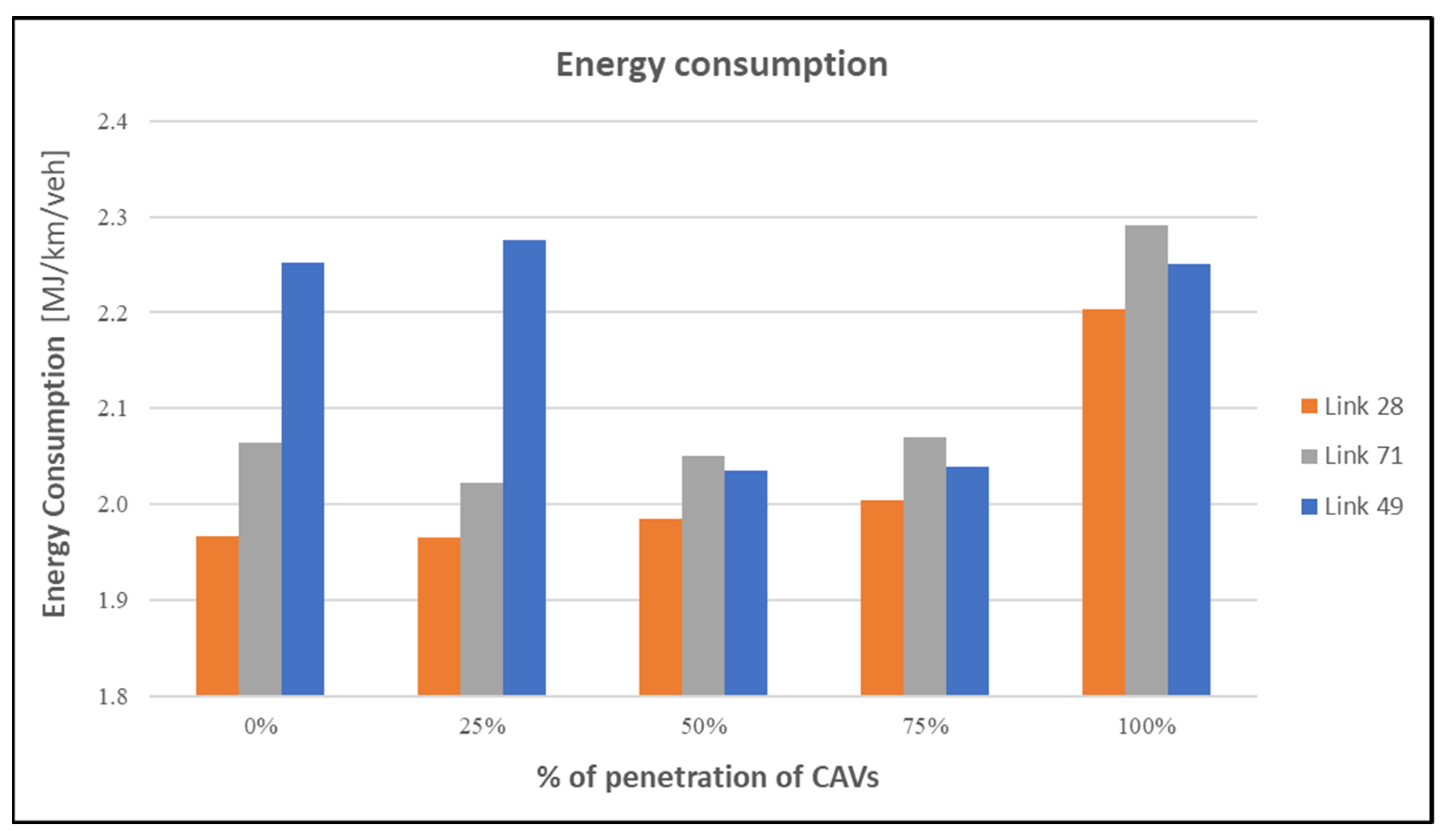
| Level | Type of Automation | Automated Functions | Description |
|---|---|---|---|
| Level 0 | No automation | None | Human driver fully controls the vehicle. |
| Level 1 | Driver assistance | One function | Assistance is provided for steering or acceleration. Human driver performs all the other activities. |
| Level 2 | Partial automation | Two functions | Assistance is provided for steering and acceleration. Human driver performs all the other functions. |
| Level 3 | Conditional automation | All | The system performs all the driving functions. Human awareness is required. |
| Level 4 | High automation | All | The system performs all the functions. Human presence is unnecessary. It is applicable under limited, specific conditions. |
| Level 5 | Full automation | All | Functions are equal to Level 4, but applicable in all driving conditions. |
| Name | Type of Connectivity | Description |
|---|---|---|
| V2V | Vehicle-to-Vehicle | Exchange of information between two or more different vehicles. |
| V2I | Vehicle-to-Infrastructure | Information is exchanged between vehicles and the infrastructure system. |
| V2P | Vehicle-to-Pedestrian | Specific technologies detect pedestrians’ presence. |
| V2N | Vehicle-to-Network | Vehicles become a “device” connected to all parts of the network and to cloud services. |
| Detector | Time Interval | Observed Volume [veh/h] | Simulated Volume [veh/h] | GEH |
|---|---|---|---|---|
| Detector 1: External Carriageway | 06:00–07:00 a.m. | 4568 | 4561 | 0.1 |
| 07:00–08:00 a.m. | 4866 | 5016 | 2.1 | |
| 08:00–09:00 a.m. | 4435 | 4445 | 0.2 | |
| Detector 1: Internal Carriageway | 06:00–07:00 a.m. | 2813 | 2666 | 2.8 |
| 07:00–08:00 a.m. | 4418 | 4168 | 3.8 | |
| 08:00–09:00 a.m. | 4336 | 4049 | 4.4 | |
| Detector 2: External Carriageway | 06:00–07:00 a.m. | 4832 | 4682 | 2.2 |
| 07:00–08:00 a.m. | 3542 | 3674 | 2.2 | |
| 08:00–09:00 a.m. | 3278 | 3293 | 0.3 | |
| Detector 3: Internal Carriageway | 06:00–07:00 a.m. | 2630 | 2612 | 0.4 |
| 07:00–08:00 a.m. | 4037 | 3965 | 1.1 | |
| 08:00–09:00 a.m. | 4121 | 4209 | 1.4 |
| Detector | Time Interval | Observed Speed [km/h] | Simulated Speed [km/h] | RMSPE | MAPE |
|---|---|---|---|---|---|
| Detector 1: External Carriageway | 06:00–07:00 a.m. | 85.90 | 86.07 | 0.134 | 0.104 |
| 07:00–08:00 a.m. | 79.60 | 62.96 | |||
| 08:00–09:00 a.m. | 79.90 | 87.77 | |||
| Detector 1: Internal Carriageway | 06:00–07:00 a.m. | 100.60 | 98.07 | 0.090 | 0.072 |
| 07:00–08:00 a.m. | 90.70 | 94.70 | |||
| 08:00–09:00 a.m. | 82.80 | 95.00 | |||
| Detector 2: External Carriageway | 06:00–07:00 a.m. | 66.50 | 54.85 | 0.186 | 0.185 |
| 07:00–08:00 a.m. | 43.80 | 36.17 | |||
| 08:00–09:00 a.m. | 43.30 | 34.40 | |||
| Detector 3: Internal Carriageway | 06:00–07:00 a.m. | 99.00 | 99.24 | 0.098 | 0.070 |
| 07:00–08:00 a.m. | 88.80 | 92.59 | |||
| 08:00–09:00 a.m. | 77.80 | 90.54 |
| Parameter | Default Values | Values for Human-Driven Vehicles | Values for CAVs (“All-Knowing”) |
|---|---|---|---|
| CC0 | 1.50 m | 1.50 m | 1.00 m |
| CC1 | 0.9 s | 1.2 s | 0.8 s |
| CC2 | 4.00 m | 4.00 m | 0.00 m |
| CC3 | −8.00 | −10.00 | −7.50 |
| CC4 | −0.35 | −0.35 | −0.10 |
| CC5 | 0.35 | 0.35 | 0.10 |
| CC6 | 11.44 | 8.00 | 0.00 |
| CC7 | 0.25 m/s2 | 0.25 m/s2 | 0.10 m/s2 |
| CC8 | 3.50 m/s2 | 3.50 m/s2 | 4.00 m/s2 |
| CC9 | 1.50 m/s2 | 1.50 m/s2 | 2.00 m/s2 |
| Maximum deceleration (own) | −4.00 m/s2 | −4.00 m/s2 | −4.00 m/s2 |
| Maximum deceleration (trailing) | −3.00 m/s2 | −3.50 m/s2 | −4.70 m/s2 |
| −1 m/s2 per distance (own) | 200.00 m | 200.00 m | 200.00 m |
| −1 m/s2 per distance (trailing) | 200.00 m | 200.00 m | 200.00 m |
| Accepted deceleration (own) | −1.00 m/s2 | −1.50 m/s2 | −1.50 m/s2 |
| Accepted deceleration (trailing) | −0.50 m/s2 | −1.00 m/s2 | −1.50 m/s2 |
| Min. clearance (front/rear) | 0.50 m | 0.40 m | 0.40 m |
| Safety distance Reduction factor | 0.60 | 0.4 | 0.3 |
| Maximum deceleration for cooperative braking | −3.00 m/s2 | −5.00 m/s2 | −8.00 m/s2 |
| Cooperative lane change | off | on | on |
| Coefficients | Values | Coefficients | Values |
|---|---|---|---|
| α | −4.7647 × 10−10 | δ | 3.7223 × 10−3 |
| β | 2.2252 × 10−7 | ε | −0.17665 |
| γ | −4.0316 × 10−5 | ζ | 5.3485 |
| Link ID | 0% CAV | 25% CAV | 50% CAV | 75% CAV | 100% CAV |
|---|---|---|---|---|---|
| Link 28 | 82 km/h | 79.6 km/h | 83.9 km/h | 88.3 km/h | 103.5 km/h |
| Link 71 | 79.5 km/h | 91.5 km/h | 95.3 km/h | 97.3 km/h | 113.4 km/h |
| Link 49 | 43.9 km/h | 49.2 km/h | 83.8 km/h | 94.6 km/h | 111.6 km/h |
Disclaimer/Publisher’s Note: The statements, opinions and data contained in all publications are solely those of the individual author(s) and contributor(s) and not of MDPI and/or the editor(s). MDPI and/or the editor(s) disclaim responsibility for any injury to people or property resulting from any ideas, methods, instructions or products referred to in the content. |
© 2023 by the authors. Licensee MDPI, Basel, Switzerland. This article is an open access article distributed under the terms and conditions of the Creative Commons Attribution (CC BY) license (https://creativecommons.org/licenses/by/4.0/).
Share and Cite
Gemma, A.; Onorato, T.; Carrese, S. Performances and Environmental Impacts of Connected and Autonomous Vehicles for Different Mixed-Traffic Scenarios. Sustainability 2023, 15, 10146. https://doi.org/10.3390/su151310146
Gemma A, Onorato T, Carrese S. Performances and Environmental Impacts of Connected and Autonomous Vehicles for Different Mixed-Traffic Scenarios. Sustainability. 2023; 15(13):10146. https://doi.org/10.3390/su151310146
Chicago/Turabian StyleGemma, Andrea, Tina Onorato, and Stefano Carrese. 2023. "Performances and Environmental Impacts of Connected and Autonomous Vehicles for Different Mixed-Traffic Scenarios" Sustainability 15, no. 13: 10146. https://doi.org/10.3390/su151310146
APA StyleGemma, A., Onorato, T., & Carrese, S. (2023). Performances and Environmental Impacts of Connected and Autonomous Vehicles for Different Mixed-Traffic Scenarios. Sustainability, 15(13), 10146. https://doi.org/10.3390/su151310146








